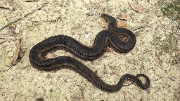Javan File Snake (Acrochordus javanicus)
Classification: Introduced Species - Javan File Snakes are a non-native species from Southeast Asia that appear to have been established in Florida since the 1970s.
Description: The elephant trunk snake possesses a wide and flat head, and its nostrils are situated on the top of the snout. Those head particularities confer to A. javanicus a certain resemblance with boas. However, its head is only as wide as its body. Females are bigger than males, and the maximum total length (including tail) of an individual is 94 inches. The dorsal side of the snake's body is brown, and its ventral side is pale yellow. The skin is baggy and loose giving the impression that it is too big for the animal. The skin is covered with small rough adjacent scales.
The top of the head has no large shields, but instead is covered with very small granular scales. There are no ventral scales. The body scales are in about 120 rows around the body. The body is stout, and the tail is short and prehensile. The elephant trunk snake is fully adapted to live underwater so much that its body cannot support its weight out of water and leaving the water can cause it serious injury.
Habitat: The elephant trunk snake has a coastal living habitat like rivers, estuaries and lagoons. But it prefers freshwater and brackish environments.
Range: The elephant trunk snake is found in South-East Asia west of the Wallace Line: southern Thailand, the west coast of Peninsular Malaysia, Singapore, Borneo (Kalimantan, Sarawak), a number of Indonesian islands (Java, Sumatra, and (possibly) Bali); possibly also in Cambodia and Vietnam, although the last is discredited by the IUCN. Although they have been introduced to a few areas in Florida, they are were thought to be established and breeding only in an artificial rock pit at Jones Trailer Park in northern Miami-Dade County. However, trapping efforts at this locality in 2003 were unsuccessful and no trapping has been conducted since, so the status of this population is currently unknown.
Found in these States:
FL
Diet: The elephant trunk snake is an ambush predator that preys on fishes and amphibians. It usually catches its prey by folding its body firmly around the prey. Its loose, baggy skin and its sharp scales find their utility by limiting any risk of escape of the prey, in particular fishes which have bodies covered with a viscous, protective mucus.
Reproduction: An aquatic snake, the elephant trunk snake is ovoviviparous, with the incubation lasting 5 to 6 months and the female expelling 6 to 17 young.
Status: This species is wide-ranging and common. It is heavily harvested for the leather trade throughout its range, however, there is no evidence that this is causing declines in the population. This species is highly fecund and reproduces quickly. Habitat destruction may affect this species in the future, and so populations and harvests should be managed and monitored. This species is listed as Least Concern.
»» Kingdom: Animalia - Animals
»» Phylum: Chordata - Chordates
»» Subphylum: Vertebrata - Vertebrates
»» Class: Reptilia - Reptiles
»» Order: Squamata - Scaled Reptiles
»» Suborder: Serpentes
»» Superfamily: Colubroidea
»» Family: Colubridae - Colubrids
»» Genus: Acrochordus
»» Species: Acrochordus javanicus - Javan File Snake
This article uses material from the Wikipedia article "Elephant trunk snake", which is released under the Creative Commons Attribution-Share-Alike License 3.0. Content may have been omitted from the original, but no content has been changed or extended.
|







